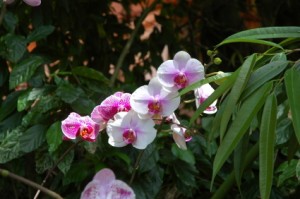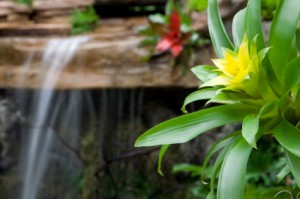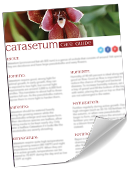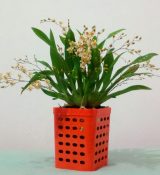How to Grow Orchids in a Terrarium
Author: Melanie Dearringer9 Comments

It is a joy to watch orchids thrive and bloom. However, many orchids can be delicate and temperamental. They produce their blossoms in only the most precise atmosphere. Depending on where you live and the resources you have available, this atmosphere can be difficult to create. One way to make it easier to control the environment is to grow orchids behind glass. Terrariums allow you to maintain consistency in the growing environment. You can monitor and control humidity, light, temperature and air flow very easily. A smaller version and the forerunner of the terrarium is the Wardian Case, which can also be used for growing orchids.
Wardian Cases
 The Wardian Case was invented by Dr. Nathaniel Bagshaw Ward in 1829. Ward was an avid hobby botanist and plant collector. His plants, however, had a difficult time growing in the polluted London air. He then noticed ferns sprouting in an enclosed glass case. He experimented with planting ferns in a glass cases and discovered that they grew well with minimal care. He then tested transporting the plants in cases on ships, which had less than ideal conditions and found that the plants survived the trips. Wardian Cases were then used to transport new specimens and agriculturally important plants all over the world. They were also used as fashionable decorations in sitting rooms in Europe and the United States.
The Wardian Case was invented by Dr. Nathaniel Bagshaw Ward in 1829. Ward was an avid hobby botanist and plant collector. His plants, however, had a difficult time growing in the polluted London air. He then noticed ferns sprouting in an enclosed glass case. He experimented with planting ferns in a glass cases and discovered that they grew well with minimal care. He then tested transporting the plants in cases on ships, which had less than ideal conditions and found that the plants survived the trips. Wardian Cases were then used to transport new specimens and agriculturally important plants all over the world. They were also used as fashionable decorations in sitting rooms in Europe and the United States.
Wardian Cases can still be used today to grow plants. They come in all shapes and sizes. They can be highly designed, purchased from specialty store, or they can be as simple and homemade as a soda bottle. If you want to grow an orchid in a Wardian Case, simply chose an orchid that will fit the size constraints of the case. Keep the case moist and out of direct sunlight, as they can become overheated easily. As all Wardian Cases are different, it will take some time and experimentation to determine how to maintain the correct environment in your Wardian Case.
Terrariums
The more modern and sophisticated version of the Wardian Case is a terrarium. Terrariums are similar to aquariums. They are enclosed glass or plastic tanks used to grow plants instead of fish. There are many different sizes and ways to grow plants in a terrarium. The first step to starting your own is to determine either the size of terrarium you want to have and then find appropriately sized plants. Or, determine how large your plants will grow and find a terrarium that will accommodate them.
Choosing the Right Orchids
Paphiopedilum; miniature Phalaenopsis; Masdevallia and other Pleurothallids; jewel orchids; and miniature Angraecum species and hybrids are all orchids that would do well in a terrarium. They are appropriately sized and handle humidity well. If there are other orchids you are interested in growing, be sure to discuss how big they will grow with your supplier. You also want to make sure they can handle moderate temperatures, and low to mid levels of light. It is also likely that you will want to find filler plants to accompany your orchids in the terrarium. Small ferns, ivy and fibrous-rooted begonias are a few examples of plants that are correctly sized and enjoy humidity.
Cleaning
Before you place the plants in the terrarium you must wash the tank thoroughly. In an enclosed environment it is easy for disease to spread quickly, or for left over salt residues to destroy your plants. If it is a new terrarium wash it with soap and water, rinse it well and allow it to dry. If it is a used terrarium, you will want to wash it several times, allowing it to dry completely between each wash. You can also rinse it with a very diluted bleach solution and then wash it again, this will remove any harmful bacteria and prevent your plants from disease or becoming unsightly.
Substrate
Next you must choose your substrate. You can use a layer of egg shell crate on the bottom of the terrarium. This will keep the plants from sitting in water, allow air movement and is easily removed if you want to start a new terrarium. Another option is to place a two inch layer of small stones at the bottom. Be sure to wash the stones carefully first. The last option is to use soil. While soil looks nice, it is very difficult to clean out when needed, and has the potential to introduce disease in the terrarium. No matter what substrate you use, it is wise to keep your orchids in their original pots. You can place the pots in the terrarium, and place sphagnum moss around them to hide the pots. If you choose to use soil, bury the orchid in its original pot and plant the companion plants directly in the soil. You can also use other props, such as drift wood or cork, to create a scene and hide the pots of the plants. Be aware that anything you add to the terrarium, including drift wood must be thoroughly washed.
Light and Temperature
 Once you have selected your plants, but before you have arranged them, it is important to find a perfect spot for the terrarium. It must receive some sunlight, but not direct sunlight. If it is placed in direct sunlight, the glass amplifies the heat and can be damaging to the plants. Also, if the window where the terrarium is located is chilly, the glass can easily become too cold. You may want to keep a thermometer in the terrarium for a few days and record the temperature at the warmest and coldest parts of the day. Make sure the plants you buy can handle these temperatures or find plants that can handle greater extremes. If your space does not have enough light, often, fluorescent bulbs can be placed in the hood the terrarium. Do not use incandescent bulbs, as these will produce too much heat.
Once you have selected your plants, but before you have arranged them, it is important to find a perfect spot for the terrarium. It must receive some sunlight, but not direct sunlight. If it is placed in direct sunlight, the glass amplifies the heat and can be damaging to the plants. Also, if the window where the terrarium is located is chilly, the glass can easily become too cold. You may want to keep a thermometer in the terrarium for a few days and record the temperature at the warmest and coldest parts of the day. Make sure the plants you buy can handle these temperatures or find plants that can handle greater extremes. If your space does not have enough light, often, fluorescent bulbs can be placed in the hood the terrarium. Do not use incandescent bulbs, as these will produce too much heat.
Air Flow
To control air flow in the terrarium, you can use a small fan placed in the top or the back. Computer fans work well for this purpose. You can make the necessary modifications to the fan yourself or you can find fans equipped for this purpose in specialty stores. The fan will help keep the air moving and prevent the terrarium from becoming stagnant.
Humidity
If you chose to use rocks in the bottom of your terrarium you can put about and inch of water on the bottom of the terrarium. This will provide appropriate humidity for the terrarium. If you used the egg crates or soil, mist the terrarium thoroughly on a regular basis. Monitor the terrarium regularly especially if you are using a fan to make sure it does not completely dry out. Be sure to use distilled water to mist and water your terrarium so that there is no risk of contaminating anything with salt residues.
Getting it Right
It will take some experimentation to get the conditions in your terrarium exactly right for the orchids you choose to grow. However, once you get things set up appropriately the terrarium will require little more attention. The scene you create will be ideal for the orchids to prosper. There are a number of ways you can grow orchids in your home and add to your collection. If you don’t have a greenhouse, a terrarium is a great way to keep your collection growing and thriving, as well as add a green, tranquil scene to your home.
Sources
“Wardian Case” Wikipedia http://en.wikipedia.org/wiki/Wardian_case
“How to Grow Orchids in a Terrarium” Garden Guides http://www.gardenguides.com/119688-grow-orchids-terrarium.html
“Enclosed Orchids: Growing in Wardian Cases and Terrariums” http://www.usbg.gov/education/events/loader.cfm?csModule=security/getfile&pageid=18171
“Terrariums” http://www.cloudsorchids.com/culture/terrer.htm
9 Responses to “How to Grow Orchids in a Terrarium”
Leave a Reply


Ask an Expert
Questions about orchids?
Our experts love a challenge!
Photo of the Week
Submit your photo to be featured on the blog!
More Photo of the Week Winners
Submit Photo








Some good tips here, love your attention to detail, washing the inside, cleaning the rocks so as to keep the inside of your Terrarium clean.
good advice with the thermometer as well.
How often do you water the orchid? Do you just put water on the rocks, or water the pot that the orchid is in?
Thank you!
how aften do I water a miniature Phalaenopsis in a Tarrarium? thanks
Can I grow sleeper orchids in a enclosed terrarium? Thanks in advance.
Hi Michael, Yes you might consider using a smaller variety, depending on the size or your terrarium. Here’s our post about growing orchids in terrariums that you might find helpful: https://www.orchidplantcare.info/growing-orchids-in-terrariums/
Thank you for all the good important information i have a 75 gallons aquarium that I turned in a terrarium for my orchids, I would like to know if I should keep it with a closed lid on top or have it open for them to get some air?
Hi Neia, most orchids need good air flow so as to avoid rot and fungal problems.
How large would a terrarium need to be for one of the orchid species in the article?
Tried this last weekend and this week, I’ve noticed it getting moldy (white fuzz). I’ll try the cleaning process again. Any other tips?